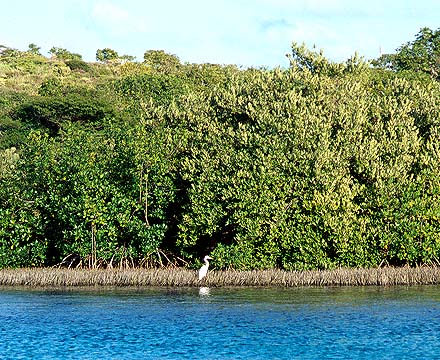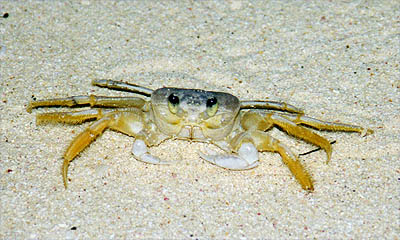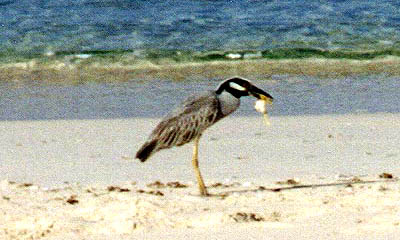Grand Turk's Tropical Reefs are home to countless exotic creatures. But Grand Turk's beaches, shorelines, and desert habitats are home to a wide variety of wildlife as well. Here are some of the creatures ReefNews has seen on its expeditions to Grand Turk.

North Creek is a long salt-water bay at the north end of Grand Turk. You can find this bay on the map of Grand Turk. This shallow bay is an important habitat for the juveniles of many species of reef fishes.
This Great Egret is hunting for small fish among the mangrove trees that grow at the edges of North Creek. Notice the long roots of the mangrove trees, growing down from the tree trunks into the water like stilts. These roots give good hiding places for young fishes, helping protect them from this hungry Egret. Healthy mangroves are an important natural resource on many Caribbean islands that we must protect to help keep the reefs in good shape.

These two beautiful horses were walking along the beach one morning, grazing on the beach grasses. Although they are not wild horses, horses are allowed to wander all over the island, giving them access to the grazing land they need. Almost everyone on Grand Turk has a fence around their yard to keep the horses out of their gardens!

Donkeys also wander freely over the island. These two donkeys were near the top of the bluff overlooking North Creek near the north end of Grand Turk, not far from the Imperial Lighthouse. Notice the short grasses and small leaves on the small trees. These plants reveal that Grand Turk is a desert island that receives only a small amount of rainfall each year.

One evening as we walked along the beach, I thought the sand was moving. I had the feeling that out of the corner of my eye I could see the sand move. But when I would turn to look, there was nothing there. Certainly the sand wasn't moving. What I was seeing were Ghost Crabs. Ghost Crabs get their name because they are so hard to see. Their bodies are white, yellow, orange, and brown and help them blend in with the sand so well that they seem almost invisible. And they can run very fast, but usually when you are not looking at them.
Ghost Crabs live in burrows in the sand. They dig tunnels up to three feet deep. They can disappear into these holes in the blink of an eye, helping to give them the illusion of invisibility. The crab in this picture was about 7 inches from toe to toe, and its body was about 2.5 inches wide. Ghost Crabs are common residents of sandy beaches. We have seen Ghost Crabs throughout the Caribbean.
Ghost Crabs live in the sand above the high-water mark of the high tide. However, unlike land crabs that spend their whole lives out of the water, Ghost Crabs must return to the ocean to breed.

This long-legged beach hunter is the Yellow-crowned Night Heron. It was about 2 feet tall. Yellow-crowned Night Herons are common in the Caribbean. Yellow-crowned Night Herons eat Ghost Crabs. We watched this bird one morning, pacing up and down the beach. Its long legs give it a good view over the sand. Then, fast as lightning, the bird bent over and stood up with a Ghost Crab in its beak. It is no wonder that Ghost Crabs live in deep burrows in the sand to keep away from these hunters.
Notice where this bird was standing. Behind it you can see the waves lapping up on the beach at the edge of the sea. Then there is a layer of water on the sand, as the waves wash up and down the beach. The sand on this beach is smooth where the waves have washed over it. But in the foreground, notice how the sand is rough. This marks the high-water mark of the high tide, the highest point on the beach that the waves could reach at the last high tide. The Yellow-crowned Night Heron is standing in the rough sand, above the high-water mark of the high tide, where the Ghost Crabs live.